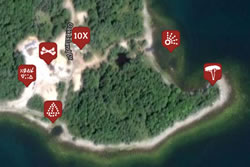Tar Kiln
Certainly given Oak Island's long history it is not impossible that a tar kiln was established by the British for the production of this substance. However, the size and nature of a tar kiln is far and removed from the scope and scale of the Oak Island workings.
Dry Dock
This theory concludes that the Money Pit was not a location of buried treasure, but instead a pumping station for a pirate drydock, making Oak Island one of the first shipyards in North America.
The works discovered on Oak Island, from the tunnels to the shafts, resemble known dry-docks found in the West Indies. Although there is no proof of a windmill structure or remnants on the island, the theory was well considered and drawn by its proponent.
As pirates were headquartered in the nearby mouth of the LaHave river during the 1690s and beyond, Oak Island made for a sheltered and feasible option for a shipyard. The supposed windmill would work to pump the lower chamber dry, the vessel would then enter the dry dock and the seaward locks are closed. A tunnel is then opened for water to leave the dry dock area and fill the lower chamber, as the windmill continues to pump that water into the upper chamber, where it is tunneled back to the sea by gravity.
As others have suggested, while this theory is possible, it seems to represent an enormous undertaking when considering the far simpler practice of careening a vessel for maintenance and repairs.
Natural Formation
Nova Scotia's geology certainly allows for sinkholes and examples have been documented in the general area of Oak Island. They can vary in size from a few feet to hundreds of feet deep.
Some suggest that if there are natural caverns in the islands' bedrock, it can account for the deep shafts, flood tunnels, and even the "tiers of oak logs" could simply occur from the forest caving into the holes.
One Oak Island candidate would be the "Cave-In Pit", referring to the spot where Mrs. Sophia Seller's oxen had fallen into a well-like hole in 1878. Later investigations of this pit presented convincing evidence that its original role was as an air-shaft for the construction of the flood tunnel from Smith's Cove, directly below.
If the Money Pit is indeed a natural phenomenon, let us simply say that "nature works in very mysterious ways".




